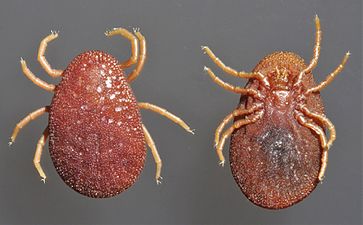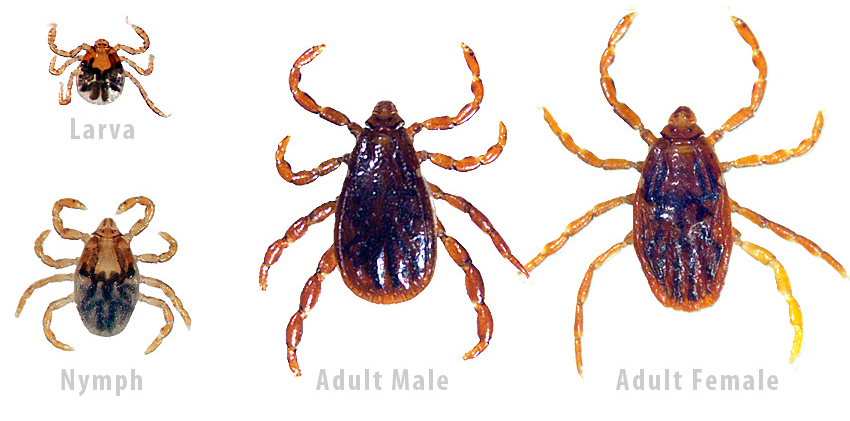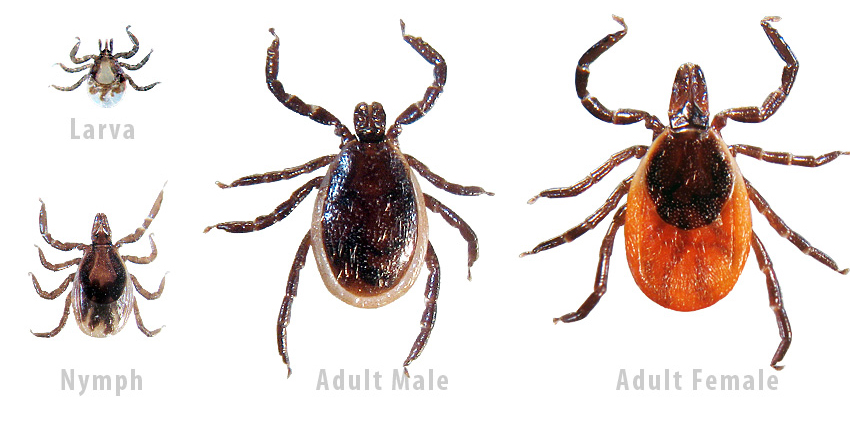
J & L Pest Control is a family owed business that has been practicing Integrated Pest Management (IPM) services since it was founded.
T (631)-605-9919
Email: jandlpestcontrol@gmail.com
J & L Pest Control
1090 Martinstien Ave.
Bay Shore, NY 11706

INTRODUCTION. The common name reflects its being an important parasite of fowl, especially poultry. In various areas it has the additional common names of chicken tick, adobe tick, tampan, and bluebug. The common name fowl tick refers to a complex of species of which Argas radiatus is one of the most important poultry parasites in the southern United States, with A. persicus being much less common; other species are found primarily on wild birds. Fowl ticks are of concern because they will attack humans both in poultry houses and when they occasionally invade structures near poultry houses, and because they are vectors of avian spirochetosis in fowl. Various species are found throughout the United States, with most being found more commonly in the southern states.
RECOGNITION. Unengorged adult female about 1/8-1/2" (4-12.7 mm) long, males slightly smaller (about 1/8-5/1673-8 mm); engorged female up to about 1/2" (12.7 mm) long, 1/4" (6.4 mm) wide. Body oval but wider behind, dorsoventrally flattened (top to bottom), with a definite sutural (impressed) line separating dorsal and ventral. Color brown, turning bluish when engorged. Integument (exoskeleton) leathery, finely wrinkled with small rounded “buttons” intermingled; margin flat, composed of quadrangular plates, not striate (with parallel fine lines), evident when fully engorged; dorsum lacking scutum (dorsal plate). Eyes absent. Capitulum (mouthparts and their base) ventral, not visible from above. Males closely resemble females.
Larvae (6 legs) with capitulum anterior (on front), visible from above; smaller (about 1/3270.84 mm long) but otherwise similar to adults. Nymphs (8 legs) smaller (about 1/876.6 mm long) but otherwise similar to adults.
SIMILAR GROUPS. (1) Pigeon tick (Argas reflexus) with margin around body upturned. (2) Swallow tick (Argas cooleyi) with margin of body striate (with parallel fine lines). (3) Relapsing fever tick (Omithodoros turicata), and other ticks in Omithodoros, Otobius, and Antricola with margin of body thick, rounded, and without a definite sutural (impressed) line separating dorsal and ventral. (4) Hard ticks (Ixodidae) with capitulum (mouthparts and their base) anterior, visible from above, and scutum (dorsal shield/plate) present.
BIOLOGY. The following information is based on data for Argas radiatus. Females lay egg masses of 25-100+ eggs in cracks and crevices. They require a blood meal before each batch and lay a total of 500-700+ eggs each. Eggs hatch in 10-28 days depending on temperature and humidity. Larvae are very active until they attach to a host. They feed for about 5 days, detach, seek refuge, and molt into the 1st nymphal stage in about 7 days. Nymphs feed only at night. There are usually 3 but occasionally 4 nymphal stages before the final molt into an adult. The entire life cycle (egg to egg) requires an average of 2 months, with a range of 6 weeks to 3 months but may be prolonged in the absence of a host; A. persicus requires 39-58 days at 90°F/32°C. Adults often live for 1 year but occasionally for 3-4 years.
HABITS. Larvae are very active day and night until a host is found. Nymphs are active and feed only at night, returning to cracks and crevices for the daytime. Both males and females feed at night and become engorged in less than 1 hour.
CONTROL. The key to control is good sanitation and the reduction or elimination of cracks and crevices in poultry houses. Occasionally applying an appropriately labeled pesticide to primarily the cracks and crevices may be required.
In residential structures, a thorough crack and crevice treatment with an appropriately labeled pesticide is usually required. A good exterior perimeter treatment may be required to reduce invasion from the poultry areas; microencapsulated and wettable powder formulations work best.
Please call us today for a free estimate for the elimination of these ticks.

HABITS. The brown dog tick does not do well outdoors in the woods in the United States. They prefer warm, dry conditions where dogs live. They do not travel far after engorgement and dropping off the host. They typically move upward, a behavior that usually promotes host encounters. Brown dog ticks may attach themselves anywhere on a dog. The adults typically attach on the ears and between the toes, but the larvae (seed ticks) and nymphs typically attach on the back. Brown dog ticks are unusual among ticks in that they can complete their entire life cycle indoors. This indoor habit means that they can and have established populations in colder climates.
SIMILAR GROUPS. (1) American dog tick (Dermacentor variabilis) and other Dermacentor species have sides of basis capituli (base for mouthparts) straight, not ; laterally produced/angular, although base may be angular laterally, and abdomen with 11 festoons (rectangular areas divided by grooves) along posterior margins. (2) Lone star tick (Amblyomma americanum) has 2nd segment of palpi twice as long as wide, female with pale markings near hind end of scutum (dorsal shield). (3) Cattle tick (Boophilus annulatus) lacks anal groove and festoons. (4) Bird and rabbit ticks (Haemaphysalis spp.) lack eyes, anal groove behind anus, festoons present, 2nd segment of palpi laterally produced. (5) Ixodes spp. lack eyes, have anal groove in front of anus, lack festoons. (6) Soft ticks (Argas, Ornithodoros, etc.) lack a scutum (dorsal shield), capitulum (mouthparts and their base) ventral, not visible from above.
BIOLOGY. The engorged female drops off the host dog and seeks a sheltered spot in which to lay her mass of typically 1,000-3,000 tiny, dark brown eggs. Since she has a tendency to crawl upwards, eggs are often deposited in cracks and crevices near wall hangings, ceiling, or roofs. She dies afterwards and the eggs hatch in 19-60 days into minute, 6-legged larvae or seed ticks. They crawl down the walls and attach to a dog as soon as possible but can survive for 8 months without food or water. After engorging for 3-6 days, during which they become globular, blue, and about 1/16" (2 mm) in diameter, they drop off and seek a sheltered place in which to molt. In 6-23 days they become 8- legged, reddish brown nymphs, which can survive for about 3 months without food or water. They again attach and engorge for 4-9 days, becoming oval, about 1/8" (3 mm) wide, and dark gray. The nymphs then drop off, hide, and usually molt in 12-19 days into adults. Although the adults attach to a dog at the first opportunity, they can survive 18 months before attachment. Once attached, they engorge for 6-50 days, mate, and the females drop off to lay eggs and repeat the cycle. Under favorable conditions, the cycle can be completed in about 2 months but there are usually only 2 generations per year in the north and 4 in the south.
Although dogs are the preferred host, they will feed on other mammals (including domestic animals and humans) if dogs are not available. They rarely attack humans, but brown dog ticks can serve as vectors for Rocky Mountain spotted fever and several other disease organisms.
CONTROL. Tick control is a 4-step process.
1. Sanitation. The homeowner/occupant of the infested home and/or the owner/user of the infested kennel must thoroughly clean the home and/or kennel and remove all debris to remove/eliminate as many ticks as possible and facilitate pesticide application. Pet bedding and resting areas should receive careful attention.
2. The dog/pet must be treated, preferably by a veterinarian or grooming parlor, on the same day of treatment, either before or while the premises are being treated.
3. Indoor treatment by our pest management professional. We will treat ssing an appropriately labeled pesticide as per label instructions and thoroughness will be our key to success. We will apply the pesticide to areas frequented by the dog, paying particular attention to sleeping quarters and any resting places where ticks have probably dropped off. If the dog rests on overstuffed furniture, we'll remove the cushions and treat the cracks and crevices. Because ticks hide in secluded places to molt, other critical areas include cracks and crevices around baseboards, door frames, window frames, floor and wall crevices, around wall molding and hangings, and under the edge of carpets. If the dog can get under porches or into crawl spaces, ticks may hide in the subflooring where liquids are difficult to apply, so we'll use dusts or aerosols as needed.
4. Outdoor treatment by our pest management professional. We'll focus our treatment to the grassy and bushy areas adjacent to the home and/or kennel, the roadside, the edges of lawns and gardens, and along any footpaths/walks, as well as to any dog resting areas. Since ticks do not travel far from where they drop off their host, we'll use a wettable powder and a microencapsulated formulation which are very effective at elimination of these ticks.
Please call us today for a free estiminate for the elimination of these ticks.

INTRODUCTION. The common name blacklegged refers to their dark legs which are in contrast to the paler body and that of deer because the preferred adult host is the white¬tailed deer; in the midwest, it is called the bear tick. Blacklegged ticks are found primarily in the northeastern, mid-Atlantic, southeastern, and northcentral states in the United States, but extend into Mexico. This tick is of medical importance because it is an important vector of Lyme disease, anaplasmosis, and babesiosis. In 2002, the CDC reported that over 16.000 Americans are diagnosed with Lyme disease every year.
RECOGNITION. Unengorged female about 1/8" (2.7 mm) long, male smaller (about 1/1672 mm). Body oval, dorsoventrally flattened (top to bottom), not hard-shelled. Color orangish brown except legs, mouthparts and scutum (dorsal shield just behind mouthparts) dark reddish brown but abdomen darker when engorged; male body reddish brown overall. Scutum present, longer than wide, almost completely covering dorsum in male. Eyes lacking. Capitulum (mouthparts and their base) visible from above; hypostome (toothed median mouthpart) with apex sharply pointed. Coxa I (1st pair of legs) with internal spur (projection from coxal base) overlapping coxa II (2nd pair of legs). Abdomen with anal groove In front of anus; lacking abdominal festoons (rectangular areas divided by grooves along posterior margin). Unengorged 1st instar larvae about 1/32" (0.7-0.8 mm) long, with 6 legs; 2nd instar nymphs about 1/16" (1.1-1.8 mm) long, with 8 legs.
BIOLOGY. Although the life cycle (egg to egg) can be completed in 2 years in nature, it may be extended to 4 years if hosts are scarce. Adult ticks feed during the winter primarily on the white-tailed deer, Odocoileus virginianus (Zimmermann). Here they mate, with the male dying shortly after mating and the female remaining on the host. In the spring, the female drops off the host and deposits about 3,000 eggs. The 6-legged larvae hatch out in several weeks (48-135 days) and can be found June through September. They feed for 3-9 days but only once, usually on small mammals such as mice, chipmunks, voles, etc. but the preferred larval host is the white-footed mouse, Peromyscus leucopus Rafinesque.
Larvae feeding before September molt promptly and overwinter as 8-legged nymphs; those which feed later, overwinter engorged and molt into nymphs the following spring. Nymphs feed for 3-8 days but only once during the summer, usually on mice or larger mammals such as squirrels, raccoons, opossums, skunks, dogs, and humans, or on birds. Nymphs can be found from April through August, with the population usually peaking in June or July. These fed nymphs then require 25-56 days to molt into adults in the autumn. The adults attach primarily to the white-tailed deer, engorge, and mate. The male dies after mating but the female continues to feed until egg development is completed and remains on the deer until spring when she drops off to lay eggs. Shortly after her eggs are laid, the female dies. If adults do not feed during their first season (autumn through spring), they die before summer’s end. If nymphs do not feed their first season (summer), most die off but they can survive through 2 seasons (May through August of the next year); they develop into adults in the same year in which they feed. Unfed larvae survive less than one year, they usually survive the winter but die during the following year.
Lyme disease is caused by the spirochete, Borrelia burgdorferi Johnson, Schmid, Hyde, Steigerwalt & Brenner, which is a corkscrew-shaped bacteria. Its primary wild reservoir is the white-footed mouse which is infected by the spring-feeding, pathogen- infected blacklegged/deer tick nymphs. These white-footed mice then serve to infest the later-feeding blacklegged/deer tick larvae, which keeps the disease cycle going. Tick eggs don’t contain the spirochete, so it is acquired via feeding. It is the pathogen-infected blacklegged/deer tick nymphs, which are most active in mid-summer (May-July) and use a wide variety of hosts, that are primarily responsible for Lyme disease in humans in the northeast and midwest. Larvae and nymphs have been collected on 29 species of mammals in 7 orders, and from 49 species of birds (23 species being migratory birds) in 17 different families.
HABITS. Blacklegged/deer ticks climb grass and shrubs to wait for a passing host, and move very little laterally. They concentrate on such vegetation located in transitional areas/zones such as where forest meets field, mowed lawn meets unmowed fence line, a foot/animal trail through high grass or forest, etc. Because these transitional areas or edge habitats are where most animals travel sometime each 24-hour period, this is where the ticks are mostly likely to acquire a host. The other habitat most likely to harbor ticks is the den, nest, or nesting area of its host such as that of skunks, raccoons, opossums, but especially the white-footed mouse. The white-footed mouse prefers woody or brushy areas. It nests in any place that gives shelter such as below ground, in stumps, logs, old bird or squirrel nests, woodpiles, buildings, etc. A favorite feeding area for these ticks on humans is at the back of the neck, at the base of the skull; long hair makes detection more difficult. However, the ticks will usually crawl about for up to 4 hours or so before they attach. Then, a tick has to be attached for a period of 6-8 hours before a successful transmission can take place.
CONTROL. The reduction of these ticks is a 5-step process. The first 2 are sanitation and personal protection, which are the responsibility of the homeowner or occupant(s) but usually require education by our Pest Management Professionals.
1. Sanitation, consists of the following: (a) keep grass cut low including around fence lines, sheds, trees, shrubs, swing sets and other difficult to cut locations; (b) remove weeds, woodpiles, and other debris which are attractive to mice as nesting areas, and leaf litter which is attractive to ticks, especially the nymphs; (c) keep garbage can lids on tightly to discourage opossums, raccoons, and skunks from coming into the yard to raid garbage cans for food because these animals all harbor the ticks which transmit the Lyme disease pathogen; (d) discourage feeding birds because the seeds attract deer mice, the major reservoir host for the Lyme disease pathogen; and (e) install a chimney screen to keep squirrels, raccoons, and birds away.
2. Personal protection, consists of: (a) use deet or permethrin containing repellent and tuck pants into socks or boots when going into suspect areas; (b) check children for ticks when they come into the house because it takes up to 4 hours, possibly longer, for the tick to start feeding; (c) wear light colored clothing which makes spotting ticks easier; (d) pets which go outdoors may increase the chance of the occupant's encounter with these ticks, especially cats; and (e) encourage the vet to check any pet's blood to determine if they are carrying the Lyme disease spirochete.
3. Inspection, is done by performing a tick drag on a routine basis in areas where the ticks have been reported or for homes adjacent to heavily wooded or uninhabited areas. The drag consists of light colored heavy-duty cloth, 7 feet long by 2 feet wide, which is securely weighted at both ends. A rope is attached to one end and this drag is walked around the suspect property.
4. Treatment of the perimeter of the property or the entire property will be done with an appropriately labeled pesticide if ticks show up on the drag. We'll use a wettable powder and microencapsulated formulations that are very effective in eliminating these ticks.
5. We'll also conduct an exterior perimeter rodent control program using PVC pipe with a glue board placed inside.
Please call us today for a free estiminate for the elimination of the these ticks.
